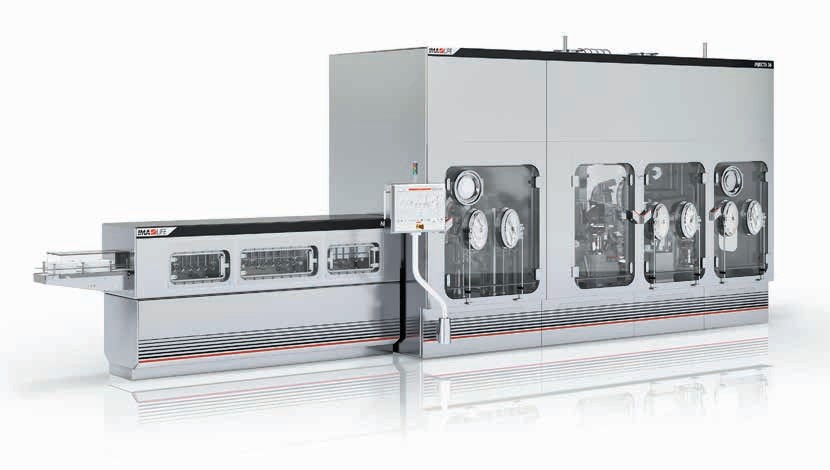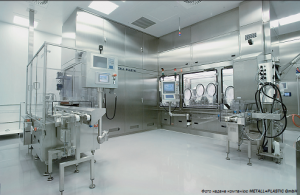Executive Summary
The pharmaceutical industry demands high adaptability and compliance in a fast-paced market where time-to-market is a critical differentiator. IMA Life has developed advanced technologies that address these needs: INJECTA 36 and NEBULA. INJECTA 36 is a high-performance aseptic fill-finish solution designed to bring maximum throughput, flexibility and scalability with a strong focus on pre-filled syringes (PFS). NEBULA is a continuous decontamination system employing vaporized hydrogen peroxide (VHP) for efficient RTU (Ready-To-Use) component decontamination. This white paper details the advantages of combining INJECTA 36’s high-speed fill-finish capability with NEBULA's robust surface decontamination to optimize aseptic manufacturing, reduce contamination risks, and streamline production.
- Industry Challenges
Flexibility in handling various container formats, such as vials, syringes, and cartridges, is essential for CDMOs and large pharmaceutical manufacturers. These companies also face stringent GMP compliance requirements, which necessitate innovative solutions to reduce time-to-market without compromising quality or patient safety.
The handling of RTU components introduces additional considerations in aseptic manufacturing. Traditional bulk handling methods, which rely on washers and depyrogenation tunnels, are increasingly being supplemented or replaced by RTU systems for pre-sterilized materials. However, conventional methods for introducing RTU components into Grade A environments pose operational and regulatory challenges, including managing the sterility of packaging and reducing contamination risks during handling.
- INJECTA 36: Pioneering Aseptic Fill-Finish Solution
INJECTA 36 was developed to meet the highest industry standards, providing an aseptic fill-finish solution that minimizes operator intervention through advanced robotics and automation. Key features of INJECTA 36 include:
- Scalability: It can handle high volumes, including up to 36,000 syringes per hour, with a streamlined and flexible design that easily adapts to varying production scales in a minimal plant layout.
- Adaptable IPC process: It is capable of executing a real-time switch between statistical and 100% In-Process Control (IPC) when requested during production. This is a significant advancement, ensuring that each dose produced meets precise quality standards, saving drug product at the beginning and end of the batch, all while maintaining maximum throughput during production.
- Enhanced Sterility and Compliance: With six-axis robots designed for high-speed manipulation, no-contact handling of RTU components, INJECTA 36 is designed to reduce contamination risks and size parts significantly. Moreover, the machine is designed to maximize first air protection and support a state-of-the-art aseptic technique for cleaning, decontamination and direct and indirect contact parts management.
- Advanced Technology Integration: Automatic weight-cell calibration, along with downstream inspection systems for plunger presence, ensures high accuracy and minimal human intervention, thereby supporting consistent aseptic conditions and reducing human error.
Through these innovations, INJECTA 36 provides pharmaceutical manufacturers with a solution to improve operational efficiency, enhance sterility assurance, and ensure GMP compliance in aseptic fill-finish processes.
- NEBULA: Revolutionizing Surface Decontamination
NEBULA represents a cutting-edge approach to RTU component decontamination, overcoming the limitations of traditional No-Touch-Transfer (NTT) and surface decontamination methods. It leverages high-concentration vaporized hydrogen peroxide (VHP) to decontaminate RTU containers in a dynamic, continuous flow system. Notable features of NEBULA include:
- High-Efficiency Decontamination: Achieves a 6-log reduction in bioburden within approximately 30 seconds using VHP at concentrations exceeding 6000 PPM.
- Continuous Operation: Through a three-chamber system, NEBULA allows continuous decontamination with minimal downtime, accommodating up to 6 tubs/trays per minute.
- Dynamic Chamber Segregation: A patented design uses computational fluid dynamics (CFD) and diffusion rings to ensure VHP containment without requiring airtight barriers, facilitating smooth material transfer.
- Minimize residues: Achieve very low H2O2 residues on the RTU components using multiple desorption strategies, supported by specific investigation, up to PPB level, during qualification.
NEBULA’s ability to continuously process high-speed RTU introductions enhances sterility without extensive mechanical complexity, making it an efficient solution for aseptic processing environments.
- Integrating INJECTA 36 and NEBULA for Optimal Aseptic Processing
Combining INJECTA 36’s high-speed, aseptic fill-finish capabilities with NEBULA’s continuous decontamination tunnel creates a comprehensive solution that addresses key challenges in modern pharmaceutical manufacturing.
Key Advantages of the Integrated Solution:
- Enhanced Throughput and Flexibility: The high-speed fill-finish capability of INJECTA 36 complements NEBULA’s ability to decontaminate RTU containers continuously, allowing for rapid processing of large volumes with minimal delays.
- Improved Sterility Assurance: NEBULA’s robust decontamination process mitigates the limitations of traditional NTT methods, ensuring a contamination-free environment for RTU components before they enter the aseptic fill-finish process. This integration supports GMP compliance and minimizes the risk of contamination, enhancing overall sterility.
- Operational Efficiency and Reduced Downtime: The combination of INJECTA 36 and NEBULA significantly reduces the need for re-qualification and manual intervention. Automatic un-bagging, continuous decontamination, and robot-assisted handling minimize operator exposure and streamline workflows, resulting in higher productivity and reduced downtimes.
- Scalability and Layout Optimization: Both INJECTA 36 and NEBULA are designed with modularity in mind. INJECTA’s reduced isolator shell width improves space efficiency, while NEBULA’s compact tunnel system reduces the spatial footprint typically associated with high-speed RTU handling. Together, they offer a scalable solution that can adapt to production volume requirements without occupying excessive cleanroom floor space.
- Conclusion
The integration of INJECTA 36 with NEBULA’s continuous decontamination tunnel represents a breakthrough in aseptic processing technology, offering pharmaceutical manufacturers a combined solution for high-speed fill-finish activities and efficient RTU decontamination. With NEBULA’s continuous VHP system ensuring consistent, high-log decontamination and INJECTA 36’s robotic flexibility supporting high throughput with minimal contamination risks, this integrated system provides unmatched efficiency and compliance.
Pharmaceutical companies that adopt this combination can achieve faster time-to-market, optimize operational efficiency, and meet rigorous GMP standards - especially vital for time-sensitive products such as vaccines, Monoclonal Antibodies (mAb)-based drugs, advanced biological drugs and essential medications.
This integrated approach promises to set a new standard in aseptic manufacturing, enabling the pharmaceutical industry to keep pace with growing demands while maintaining the highest quality and safety standards.



